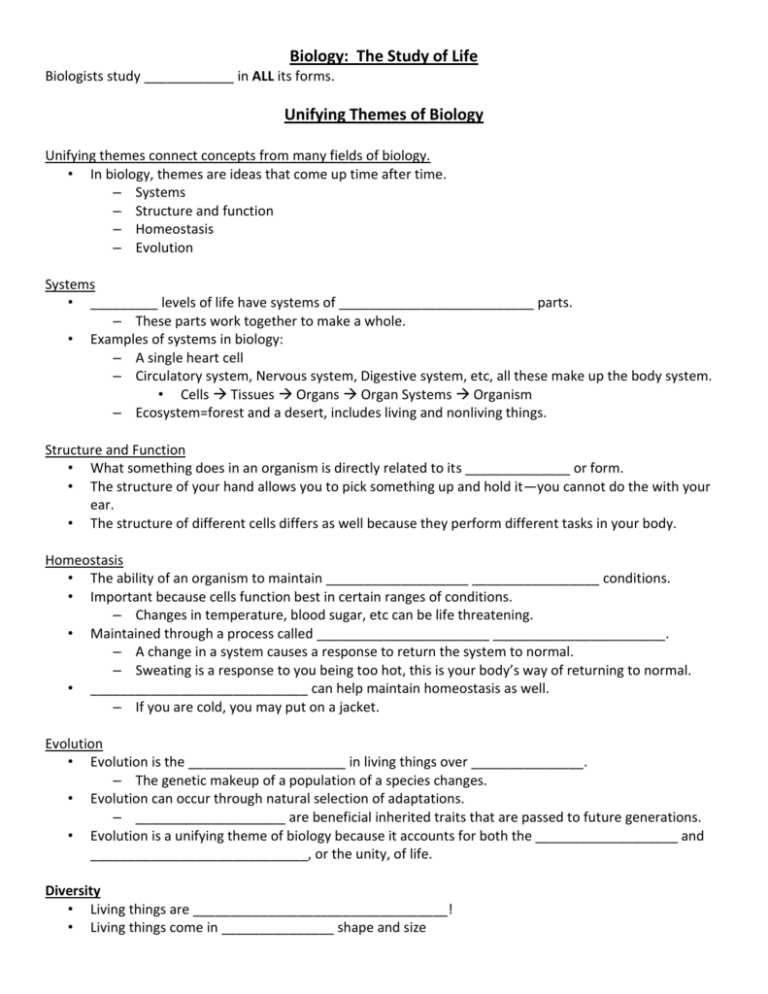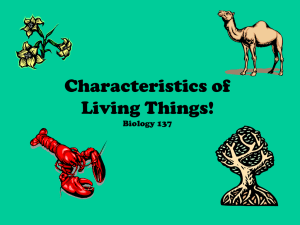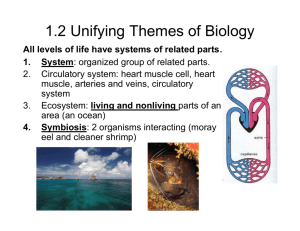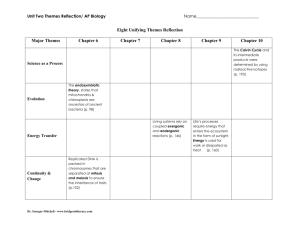Biology: The Study of Life Unifying Themes of Biology
advertisement

Biology: The Study of Life Biologists study ____________ in ALL its forms. Unifying Themes of Biology Unifying themes connect concepts from many fields of biology. • In biology, themes are ideas that come up time after time. – Systems – Structure and function – Homeostasis – Evolution Systems • _________ levels of life have systems of __________________________ parts. – These parts work together to make a whole. • Examples of systems in biology: – A single heart cell – Circulatory system, Nervous system, Digestive system, etc, all these make up the body system. • Cells Tissues Organs Organ Systems Organism – Ecosystem=forest and a desert, includes living and nonliving things. Structure and Function • What something does in an organism is directly related to its ______________ or form. • The structure of your hand allows you to pick something up and hold it—you cannot do the with your ear. • The structure of different cells differs as well because they perform different tasks in your body. Homeostasis • The ability of an organism to maintain ___________________ _________________ conditions. • Important because cells function best in certain ranges of conditions. – Changes in temperature, blood sugar, etc can be life threatening. • Maintained through a process called _______________________ _______________________. – A change in a system causes a response to return the system to normal. – Sweating is a response to you being too hot, this is your body’s way of returning to normal. • _____________________________ can help maintain homeostasis as well. – If you are cold, you may put on a jacket. Evolution • Evolution is the _____________________ in living things over _______________. – The genetic makeup of a population of a species changes. • Evolution can occur through natural selection of adaptations. – ____________________ are beneficial inherited traits that are passed to future generations. • Evolution is a unifying theme of biology because it accounts for both the ___________________ and _____________________________, or the unity, of life. Diversity • Living things are __________________________________! • Living things come in _______________ shape and size Biodiversity is… • The _____________________ of life. – All the different types of life on Earth. • _____________________ diversity ___________________ to the equator. – Life thrives better in warm areas – Larger food supply Species… • A type of ____________________ thing that can breed and _______________________. – Humans – Monarch butterflies ALL living organisms share 4 characteristics… 1. ALL living organisms are made of _________________. 2. ALL living organisms obtain and use ____________________. 3. ALL living organisms respond to the _____________________________. 4. ALL living organisms are capable of ________________________ and developing. Cells • • • The ___________ unit of ___________ _________________________-celled organisms ________________-celled organisms – Some cells have specialized functions, for example, muscle cells contract and relax, your stomach cells secrete digestive juices. – Specialized cells put together make you a complete organism. Obtain and Use Energy • _____________________ is the ability to cause a change or to do work. • __________________________ energy is the form of energy used by living things. • Energy is important for _____________________, or all of the chemical processes that build up or break down materials. • Plants use energy from the ____________ to make their own food. • ___________________ get their energy by eating other organisms. Response to Environment • Light, temperature, and touch are _________________ factors, or stimuli, that organisms respond to. • One of your responses is to contract the pupils of your eyes when you are in bright sunlight. • Other organisms respond to changes is light. – For example: plants grow towards light. Reproduction and Development • Important for _______________________ of a species. – Species must be able to _____________________ new individuals. – The ____________________ must be able to grow and develop so that they can reproduce. • ____________________ information is passed from parent to offspring. – Molecular instructions for growth and development are found in _________.











